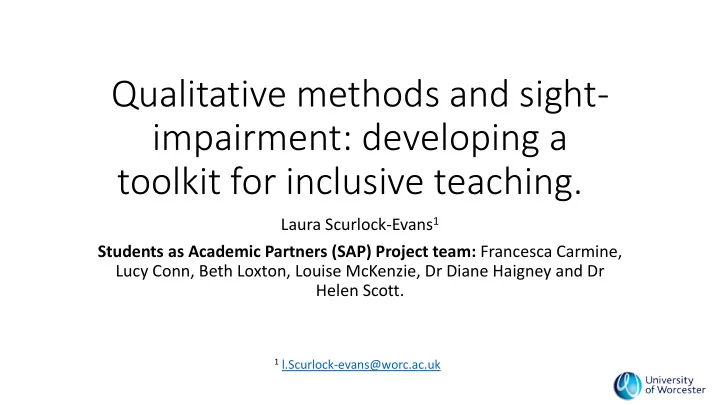

Qualitative methods and sight- impairment: developing a toolkit for inclusive teaching. Laura Scurlock-Evans 1 Students as Academic Partners (SAP) Project team: Francesca Carmine, Lucy Conn, Beth Loxton, Louise McKenzie, Dr Diane Haigney and Dr Helen Scott. 1 l.Scurlock-evans@worc.ac.uk
Context • Approximately 15 in every 10 000 Higher Education (HE) students in the UK have a sight impairment (HESA, 2014). • Recent cuts to funding of provision of support (e.g. Weale, 2015) mean inclusive approaches to teaching and learning in HE is a key priority (e.g. Meyer, Rose & Gordon, 2014). • Not always clear to tutors what inclusive teaching practice is, particularly with regards to research methods training (Godfrey & Loots, 2015). • Although some literature to guide inclusive practice for teaching quantitative research methods exist, no best practice guidelines for qualitative research methods are available.
Context continued • Defining: • Sight impairment Subtheme a • Qualitative research methods Theme 1 Theme 3 Subtheme b Theme 4 Theme 2 Subtheme c Subtheme a Subtheme c Subtheme a Subtheme b Subtheme b
SAP project aims • Staff and students to work collaboratively to explore: • barriers to the learning and teaching of qualitative research methods; • strategies to manage them; • development of a toolkit.
Methods • Opportunistic and snowball sample of five participants (n = 3 tutors, n = 2 students) • Semi-structured, face-to-face interviews lasting between 15-60 minutes were audio-recorded, transcribed verbatim and analysed using thematic analysis (Braun & Clarke, 2006). • Ethical approval granted by the Institute of Health and Society’s research ethics committee (HCA17180041-R).
Preliminary findings • Data analysis and toolkit development are ongoing, but four initial themes identified challenges across qualitative research methods (i.e. finding/reviewing literature, data collection, data analysis and presenting findings). • Four key themes: the learning curve, understanding assistive technology, communication and partnership, and universal design.
Learning curve • Recognising diversity at the outset • One size fits all approach to adaptation won’t work • Tutors – lacking in confidence • Trial and error approach needed to empower learners “If right now, their visual impairment on paper… they’ve both got the same visual impairment, their experience of being a visually impaired person is completely different” (Participant 05, tutor).
Understanding assistive technology • Independent learning a key feature of participants’ talk • External resources not accessible • Disruption to flow • Pervasive misunderstandings of how assistive technology works “[The screen-reader] doesn’t necessarily recognise inflections, or commas and things very well, and either overcompensates for them… or it doesn’t read any of them… so it’s like, was that meant to be said in this way, or is it not?” (Participant 04, student).
Communication and partnership • What, who and how to ask questions? • Shared understanding • Dynamic and open dialogue “I remember being really frustrated about it for a while, until I sort of just sat down with some of my lecturers, and we went through it all” (Participant 03, student).
Universal design • Keep the social and psychological aspects of learning in mind • Opportunities for peer learning and peer networks • Many barriers to learning methods are shared by all learners – particularly those new to the subject • Repertoire of methods • Benefits for all students “Part of [the] seminars is about the students getting together and having the opportunity to form friendships and the ability to work together, and you don’t want ‘Oh, that student is always working with the tutor’ – you don’t want to remove that opportunity” (Participant 01, tutor).
Next steps • The toolkit is development and will contain information on: • key types of assistive technology, and the potential challenges learners may experience in qualitative research methods when using them; • where to access free version of assistive technology so tutors can become familiar with and experience them and; • different approaches to adapting qualitative research methods and data analysis techniques, including considering universal design.
Reflections on the SAP project experience • Collaboration has provided opportunity: • Consider issues from multiple perspectives • Consolidate skills • Ensure feeling of inclusivity throughout the process of pedagogical research. • Worth it!
Useful websites/resources • RNIB • Information on assistive (access) technology: https://www.rnib.org.uk/information-everyday-living-using-technology- beginners-guides/beginners-guide-assistive-technology • NVDA • Free screen reader: https://www.nvaccess.org/ • Other free apps: • https://www.rnib.org.uk/information-everyday-living-using-technology- computers-and-tablets/free-accessibility-software • https://www.teachingvisuallyimpaired.com/apps-for-vi.html
References • Braun, V., & Clarke, V. (2006). Using thematic analysis in psychology. Qualitative research in psychology , 3 (2), 77-101. • Godfrey, A. J. R., & Loots, M. T. (2015). Advice From Blind Teachers on How to Teach Statistics to Blind Students. Journal of Statistics Education, 23 (3), n3. • Sawhney, K. (2014). ENGR 110-210 Perspectives in Assistive Technology Winter 2014. • Weale, S. (2015, December 3). Government to cut funding for disabled university students. The Guardian. Retrieved: https://www.theguardian.com/education/2015/dec/02/government-to- cut-funding-disabled-university-students-jo-johnson
Recommend
More recommend